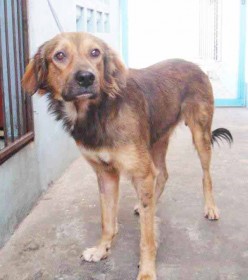Enlarged gums
Continued
Pet Corner
Last week we placed focus on sore gums (gingivitis). There is a type of gingivitis (especially to be found in Boxers and Bulldogs) in which the gums become very enlarged, so much so as to cover a major portion of the teeth. Of course, this means that, as the dog or cat eats, its own gums are bitten. In the ensuing lesions, food particles are lodged and bacteria get a chance to flourish in the wounded tissue. All in all, the entire oral hygiene effort, as described before, becomes compromised.

I should mention, in passing, that there is a form of gingival hypertrophy in which the growing tissue forms a huge mass (benign growth, not cancer), even covering the teeth. Obviously, under such conditions the jaws cannot close. This special type of gum enlargement is called Epulis. It is found more often in the short-faced dogs (Pekinese, Boxers, Bulldogs).
Surgical intervention is the only prudent solution.
Ok, enough of the gum problems.
Tongue problems
Let’s today also look at ailments associated with the tongue.
Any inflammatory condition of the tongue, irrespective of the origin, is called Glossitis or ‘sore tongue.’
The tongue is quite a magnificent organ. It has three sets of muscles running vertically, longitudinally and transversely. This means that the tongue can take on various shapes. Dogs don’t do too much chewing. Basically, they bite and swallow. The tongue helps propel the food backwards towards the oesophagus and into the stomach. In addition, the tongue is coated with sensitive taste buds which allow the animal to be discerning as to which food it accepts or rejects. Since the tongue is such an important component of the mouth, any ailment of the tongue will make eating difficult. This condition could eventually lead to starvation.
The dog/cat will firstly rely on its sense of smell to try to ascertain whether an object is

worth investigating further with the objective of consuming it. However, having made the decision to carry the investigation further, the tongue will probe the object. Therein lies the origin of many a sickness of the tongue. I had mentioned that dogs and cats, especially the young ones, are naturally curious beings. They will sniff at strange objects and, not being satisfied, they begin to probe the item with their snouts and even their tongues. In so doing, they are likely to get burned (by bleaches and acids or hot wires), or they can pick up sharp objects which embed themselves in the tongue or lip.
Over the years, I have extracted all sorts of metal shards, fish hooks and wood splinters from dogs’ tongues (cats seem to be a bit smarter in this regard, although fish bones and fish hooks tend to be stuck more often in cats’ tongues). Also, awns, spikelets, thorns and burrs from plants have been known to embed themselves in the surface of animals’ tongues.
I should mention, in passing, that foreign bodies often can get stuck in the underside of the tongue as well. These are not seen at first glance. If your dog/cat goes off food and is salivating heavily, make it a point of duty to look under the tongue for lesions or foreign bodies.
An animal with something stuck in the tongue will be salivating a lot, gagging and coughing and sometimes using its paw to extricate the cause of discomfort. The removal of these foreign bodies which are stuck in the tongue is relatively simple, if the animal will allow the manipulation. One just has to take a tweezers (the kind that women use to pluck out their eyebrows and men use to extract nasal hair), grasp the irritating object and pull it out. Of course, if the object is stuck deep into the tissue (muscle) of the tongue, or if it is something like a fish hook which will not allow itself to be extracted easily, then veterinary intervention may be necessary. The animal may need to be sedated and even anaesthetized.
So far, I have been writing about objects stuck in the tongue. Over the years we have had our fair share of cutting off all sorts of objects that surround the tongue. I have had the experience of removing the top of condom rubbers, baby’s comforters, plastic jerry-can covers, an assortment of rubber bands and twine/fishing lines which have been involved in the strangulation of the tongue by stopping the blood flow therein.
Be careful when you use the scissors or shears to remove the offending object. Bear in mind that all the gagging and swallowing might have moved the strangling object even further to the back of the tongue. Any wrong manipulation could result in you piercing the palate or worse. If you don’t possess the dexterity or the confidence or the tools (sturdy scissors, electrician’s shears, etc), then seek professional help.
Please implement disease preventative measures (vaccinations, routine dewormings, monthly anti-heartworm medication, etc) and adopt-a-pet from the GSPCA’s Animal Clinic and Shelter at Robb Street and Orange Walk, if you have the wherewithal to care well for the animals. Do not stray your unwanted pets, take them to the GSPCA’s Clinic and Shelter instead. If you do not wish your pet to have puppies or kittens, you may exploit the GSPCA’s free spay and neutering programme. If you see anyone being cruel to an animal, or if you need any technical information, please get in touch with the Clinic and Shelter by calling 226-4237.

